If you head down to the Museum this half term, you surely won’t be able to miss the Victorian Fairground taking over our Upper Yard. We’re offering up all the thrills and spills of a 19th-century funfair, including a magical carousel, a dizzying helter skelter, and much, much more.

But with all the hubbub and excitement of the fair, it’s easy to forget that there are some remarkable forces at work, keeping you firmly on the fairground rides’ seats and stopping you from disappearing into the skies over Manchester.
Here, Web Manager and STEM Ambassador Mike takes a look at the physics at play, using examples from around the world.
Roller coasters

Whether it’s a mini roller coaster for kids or Kingda Ka, the world’s tallest roller coaster, these rides all rely on Newton’s First Law of Motion, which states that:
‘Every object will remain at rest or in uniform motion in a straight line unless compelled to change its state by the action of an external force.’
A roller coaster ride will typically begin with the carriages being mechanically pulled to the top of the first drop. Once they’re at the summit, the carriages are at rest, as per Newton’s First Law. They are also a bundle of gravitational potential energy, and the higher you go, the more energy you will store.
Once the carriages go over the edge, the gravitational potential energy converts into kinetic energy. At this point, an external force—in this case, gravity—acts upon the carriages and propels them down the hill (or more accurately, pulls them back towards the Earth).
Once the carriages have completed their descent and begun their climb of the next peak, gravity begins to act against their forward motion, slowing them down. However, owing to careful roller coaster engineering, sufficient momentum of the carriages can be maintained, allowing them and their squealing, wide-eyed occupants to climb and descend several more peaks before gravity and friction (the carriages’ brakes, resistance on the track etc.) have the last laugh and bring the ride to a shuddering end.
Sure, it’ll all be over in 90 seconds, but it will have totally been worth the 90-minute queue…
Spinning rides
They go by many names: Round Up, UFO, Meteorite, Cyclone, The Swashbuckler… call it what you like, but to me, it’ll always be the Megaspin.
That name is seared into my memory after one fateful afternoon at a music festival. I got onto the Megaspin with my phone about my person and, once the ride reached a certain speed, I felt with a pang of horror my phone fly out of my pocket, too fast for me to react, and never to be found again! In fact, we’ll use my poor phone as an example to explain the forces involved in this ride a bit further on.
Hopefully you all are familiar with the ride in question: a circular platform spinning around a central vertical axis, with a cage around the edge to stop people from being flung off.
But how exactly does this ride work?
Well, if you’ve ever been on one, you’ll know that as soon as it picks up a bit of speed, your body will begin to feel as though it’s being pushed up against the wall/cage around the edge.
This is because your body and its mass start to experience what’s called centripetal force, which wants to keep your body following a curved path. At the same time, your body is resisting this curved path as it wants to travel in a straight line, at a 90 degree angle from the radius of the spinning disk. This is because your body is obediently following Newton’s First Law of Motion, as defined above with roller coasters.
In addition to Newton’s First Law of Motion, your body on the spinning ride will also start to experience the Third Law of Motion, which is that every action wants to have an equal and opposite reaction. And in this case, the opposite to the centripetal force acting on your body being spun around is centrifugal force.
Let’s use my phone to further illustrate how these forces work. My body, with my phone tucked in my pocket, began to experience an increasingly strong centripetal force as the Megaspin began to revolve faster and faster.
Once the Megaspin got to a certain speed (or technically speaking, velocity), the resulting centrifugal force my phone was experiencing suddenly overcame the centripetal force that was keeping it in my pocket.
My phone’s strict adherence to Newton’s First Law of Motion saw it break free from my pocket in a straight line, as I continued alone on my curved path, the centripetal force preventing me from doing little else than shouting a pained “Noooo!”
The key takeaway here is that centrifugal force is in the opposite direction to the centripetal force. And the heady combination of these forces is what gives your body the thrill of being spun around on these rides.
Just make sure you keep your valuables safely tucked away!
Helter skelters
We may not have a Kingda Ka or a Megaspin at our Victorian Fairground (to be honest, I think we’d struggle to fit them all in!), but what we do have is one of the most iconic rides in fairground history—the noble and timeless helter skelter.
It might not have dozens of twists and loops, nor will it send you rocketing along at breakneck speeds, but there’s a reason why such rides have persisted since Victorian times. And that’s because it appeals to one of our most irresistible primal urges—that of climbing tall things and then jumping, throwing or rolling ourselves down/off them.
And while your typical helter skelter doesn’t quite offer the same matter-of-life-and-death thrill that say, bungee jumping does, there are still some ways and means of getting the adrenaline pumping on rides like this. For instance, on the ArcellorMittal Orbit slide at the Olympic Park in London, the world’s longest and tallest slide.

As mentioned earlier, the higher you go, the more gravitational potential energy you will have. So, by the time you get to the top of the Orbit’s 178-metre-long slide, you’ll have plenty of energy stored up.
And if the height wasn’t enough, then the slide’s brushed metal flooring and the ‘sack’ that you’re required to sit in (it’s a little fancier than a sack at the Orbit, but you get the picture…) significantly reduce friction to speed you along your way, helping you to reach the bottom in just 40 seconds—fast enough to require you to wear elbow pads and rugby scrum cap for health and safety reasons!
Sources
“How Roller Coasters Work”, How Stuff Works, 2009: https://science.howstuffworks.com/engineering/structural/roller-coaster3.htm
“Newton’s First Law”, NASA: https://www.grc.nasa.gov/www/k-12/airplane/newton1g.html
“Round Up (Ride)”, Wikipedia: https://en.wikipedia.org/wiki/Round_Up_(ride)
“Centrifugal Force Caused by Inertia”, Ron Kurtus, 2016: www.school-for-champions.com/science/force_centrifugal.htm
“Why You Feel the Urge to Jump”, Jessica Seigel, March 30, 2017: http://nautil.us/issue/46/balance/why-you-feel-the-urge-to-jump
Image credits
Kingda Ka image: ‘Höchste Achterbahn der Welt: Kingda Ka‘ by Dusso Janladde. Used under CC BY-SA 3.0 license.
Meteorite image: ‘The Meteorite in action at Worden Park‘ by Michael Elleray. Used under CC BY 2.0 license.
Helter skelter image: ‘Helter Skelter ride at Isle of Wight Festival 2011‘ by Laura. Used under CC BY 2.0 license.
ArcellorMittal Orbit image: taken from ArcellorMittal’s corporate YouTube channel.



Perfect! Just what I need for a project for my NS 9 class. Thank you!
thi is very helpful for home lerning